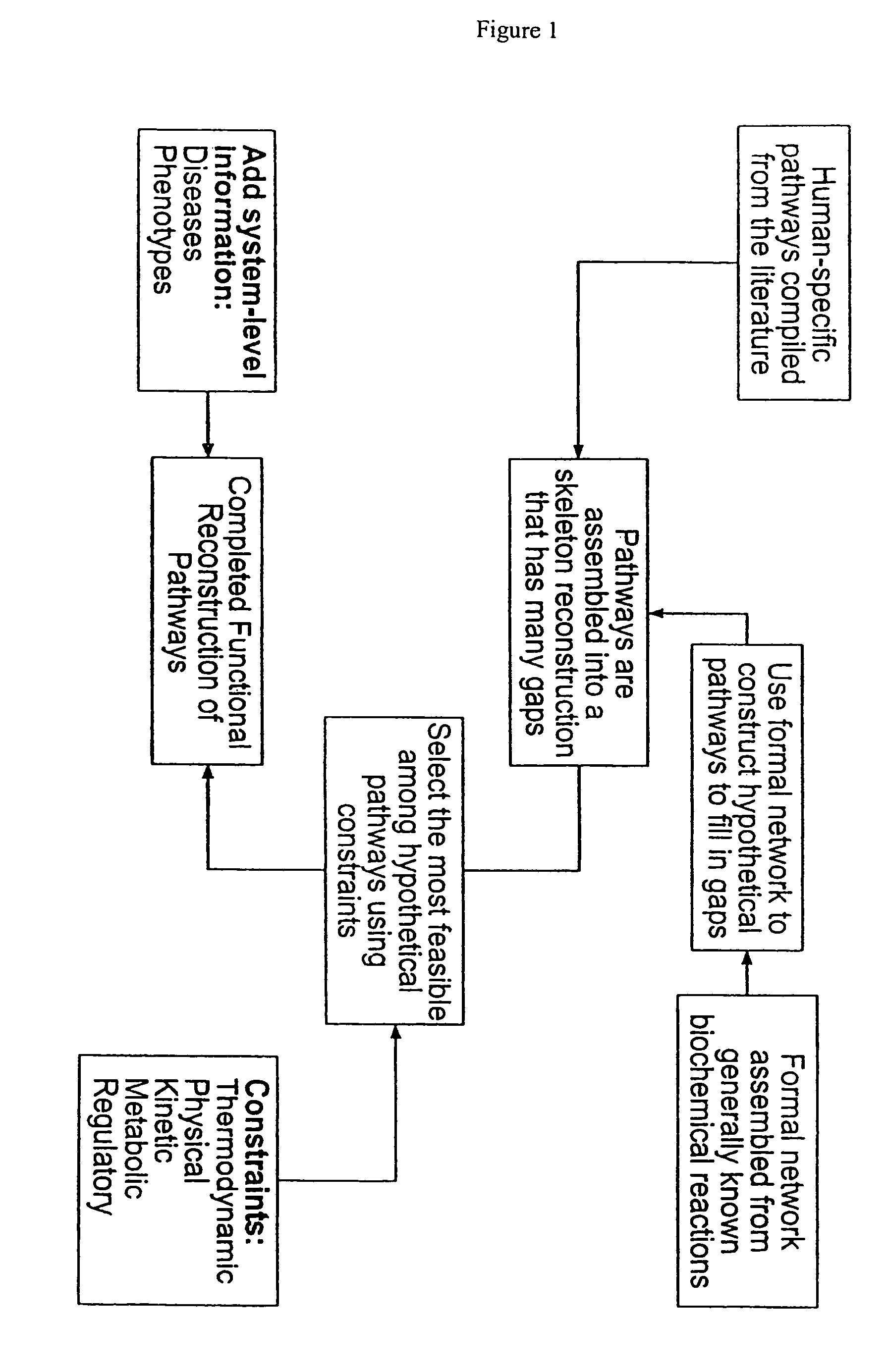Methods for identification of novel protein drug targets and biomarkers utilizing functional networks
a functional network and protein drug technology, applied in the field of bioinformatics technologies, can solve the problems of eukaryotic organism metabolic reconstruction remains a much more complicated problem, the goal is still far off, and the expectation is far from reality
- Summary
- Abstract
- Description
- Claims
- Application Information
AI Technical Summary
Benefits of technology
Problems solved by technology
Method used
Image
Examples
example 1
Stabilization of Heparin for Treatment of Arteriosclerosis
[0186]HC gp-39, a protein of the chitinase family, can be used in combination with heparin to treat arteriosclerosis. Addition of HC gp-39 may stabilize heparin and increase its effectiveness.
[0187]Heparin appears to play a role in arteriosclerosis. Data shows that patients suffering from arteriosclerosis have decreased heparin levels. □ Therapeutic treatment with heparin is used to reduce the risk of infarction and stroke. Heparin is also used as an anti-coagulant. It activates antithrombin-III. Additionally, low molecular weight heparin is used for the treatment of lipid metabolism disorders as an agent that activates lipoprotein lipase.
[0188]Under normal conditions, lipoprotein lipase is localized on the cell surface, including the surface of endothelial cells in blood vessels. The binding of heparan sulfate to lipoprotein lipase is responsible for the retention of lipoprotein lipase on the cell surface. While bound to the...
example 2
[0194]In most tissues, cells are connected through a membrane-based complex of polysaccharides and through membrane-linked proteins known as the glycocalix and the extra-cellular matrix. Heparan sulphate is one of the most important components of both the glycocalix and the extra-cellular matrix. Heparan sulphate binds to fibronectin and other structural proteins; this binding is required for the fixation of cells within tissues and determines tissue structure (FIG. 5). The mechanisms of binding between heparan sulphate and fibronectin have been studied, and this binding is significant in the positioning of fibroblasts, epidermal cells, and endothelium (PMID 3917945, 8838671, 10899711). It has also been shown that heparan sulphate binds to thrombospondin during the establishment of the intercellular contacts (PMID 1940309), and that there is a correlation between cell aggregation and the binding of heparan sulphate with syndecan-1 (PMID 7890615).
[0195]HC gp-39, a pr...
example 3
[0196]Hyaluronic acid (HA) binds to smooth muscle cells and prevents their proliferation. Proliferation of smooth muscle cells in arteriosclerosis leads to the growth of the arteriosclerotic plaque. Therefore, HA is a factor that helps contain the disease. Chitotriosidase, or chitinase 1, may restrict the synthesis of HA by degrading the chitin primers necessary for HA formation. Therefore, chitotriosidase facilitates the growth of arteriosclerotic plaques. Suppression of the activity of chitotriosidase may be useful in the treatment of atherosclerosis (see FIGS. 4A and 4B).
[0197]Hyaluronic acid is involved in various processes of tissue repair and remodeling. In particular, HA plays a role in the regulating the migration and proliferation of smooth muscle cells which are critical in the pathogenesis of cardiovascular diseases. HA acts as a negative regulator of the proliferation of smooth muscle cells induced by platelet-derived growth factor (PDGF) and as a positiv...
PUM
 Login to View More
Login to View More Abstract
Description
Claims
Application Information
 Login to View More
Login to View More - R&D
- Intellectual Property
- Life Sciences
- Materials
- Tech Scout
- Unparalleled Data Quality
- Higher Quality Content
- 60% Fewer Hallucinations
Browse by: Latest US Patents, China's latest patents, Technical Efficacy Thesaurus, Application Domain, Technology Topic, Popular Technical Reports.
© 2025 PatSnap. All rights reserved.Legal|Privacy policy|Modern Slavery Act Transparency Statement|Sitemap|About US| Contact US: help@patsnap.com



